
Am Fam Physician. 2017;95(7):425-432
Patient information: See related handout on exercise for seniors, written by the authors of this article.
Author disclosure: No relevant financial affiliations.
Regular physical activity and exercise are important for healthy aging and are beneficial for chronic disease management. Exercise prescriptions for older adults should account for the individual's health status and functional capacity. Any amount of exercise is better than being sedentary, even if health status prevents a person from achieving recommended goals. For most health outcomes, more benefits occur with physical activity performed at higher intensity, greater frequency, or longer duration. Guidelines recommend at least 150 minutes of moderate-intensity aerobic activity or 75 minutes of vigorous-intensity aerobic activity and at least two days of muscle-strengthening activities per week. Key components of the prescription include setting achievable activity goals, identifying barriers and providing potential solutions, and providing specific recommendations on the type, frequency, and intensity of activities. Older adults will derive distinct benefits from aerobic exercise, strength or resistance training, flexibility or stretching exercises, and balance training. Many community resources are available to help older adults begin a more active lifestyle.
The benefits of regular physical activity and exercise on general health and overall quality of life in older adults are well established,1 and these benefits are particularly salient among patients with chronic medical conditions such as osteoarthritis or cardiovascular disease (CVD).2 However, in 2013, more than 33% of adults 65 years or older reported no leisure-time physical activities.1 Only 16% of older adults met national guideline recommendations for physical activity, which are at least 150 minutes of moderate-intensity aerobic activity or 75 minutes of vigorous-intensity aerobic activity and two or more days of muscle-strengthening activities per week.1 Barriers to exercise include a lack of knowledge, lack of motivation, and poor health.2
| Clinical recommendation | Evidence rating | References |
|---|---|---|
| For older adults, any physical activity is better than being sedentary. Reducing sedentary time has cardiovascular, metabolic, and functional benefits. | B | 10, 11, 14, 16, 24 |
| Resistance training preserves muscle strength and physical functioning in older adults. | A | 21, 22 |
| To promote and maintain health, older adults should aim for at least 150 minutes of moderate-intensity aerobic activity and two or more days of resistance training per week. | B | 21, 24, 30 |
| Flexibility exercises improve and maintain joint range of movement in older adults. | C | 24 |
| Balance exercises (e.g., tai chi, yoga) can improve or maintain physical function and reduce falls in older adults at risk of falling. | A | 20, 25 |
| Physical activity decreases the risk of chronic diseases and enhances treatment. | B | 14, 16, 24, 38 |
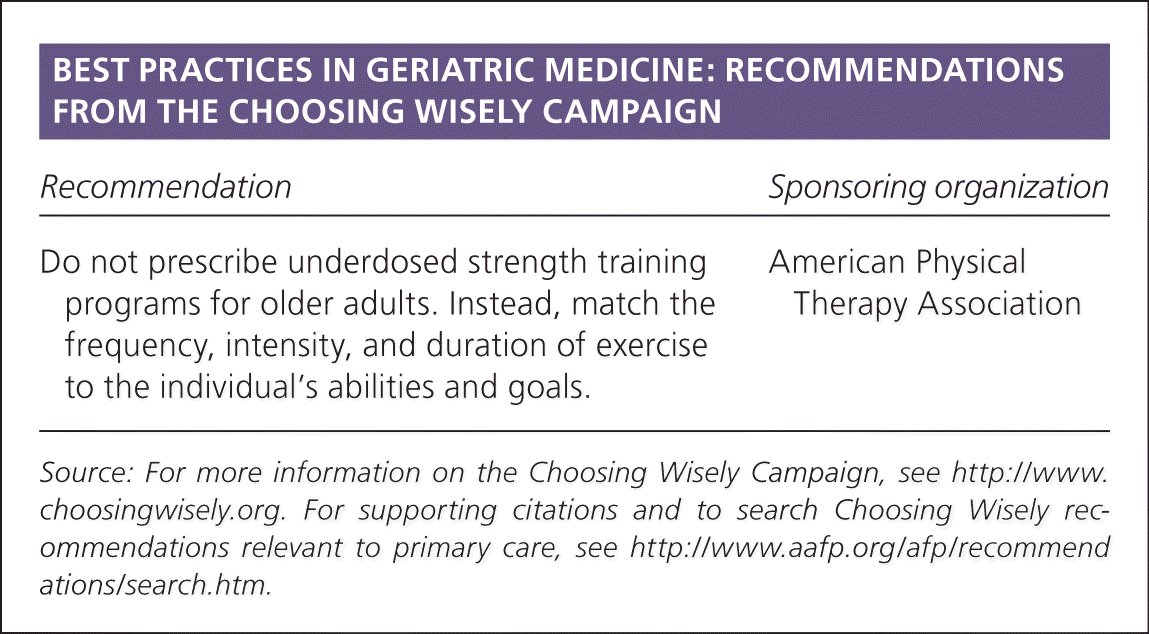
| Recommendation | Sponsoring organization |
|---|---|
| Do not prescribe underdosed strength training programs for older adults. Instead, match the frequency, intensity, and duration of exercise to the individual's abilities and goals. | American Physical Therapy Association |
Many primary care physicians agree that counseling to promote physical activity and a healthy diet is important to their patients.3 The U.S. Preventive Services Task Force recommends that primary care physicians provide behavioral counseling to promote a healthful diet and physical activity for CVD prevention in adults with CVD risk factors.4 This article reviews the recent evidence supporting physical activity among older adults, and aims to help physicians effectively counsel older patients to increase physical activity.
Important Considerations in Older Adults
Older adults are heterogeneous with respect to their health status and physical function.5 Normal aging is associated with reduced functional capacity and strength, and degenerative musculoskeletal conditions. Older adults at any submaximal exercise load tend to exert at a higher percentage of their maximal capacity and effort than younger persons.6 Additionally, older adults are more likely than younger adults to engage in physical activities at lower intensities.7 Although many older adults are functionally independent and able to participate in most exercise programs, others may have multiple chronic diseases and geriatric conditions, such as cognitive impairment and recurrent falls, limiting their ability to participate in certain types of exercise.5
Sedentary Behavior vs. Physical Activity
Sedentary time increases with older age,8 and excessive time spent in sedentary behavior, such as sitting, is associated with deleterious health outcomes including abnormal glucose metabolism and increased mortality.9 Reducing sedentary time, independent of physical activity, has known cardiovascular, metabolic, and functional benefits in older adults.10,11 One study found that among men 71 years or older whose physical activity exceeded current guidelines, more time spent in sedentary behavior was associated with greater mortality risk.12 Any amount of exercise is better than being sedentary, even if the individual's health status prevents the achievement of recommended goals.
Key Components of an Exercise Prescription
For most health outcomes, benefits increase as the amount of physical activity increases through higher intensity, greater frequency, or longer duration.13,14 A verbal or written recommendation for physical activity should include a specific activity (modality), its frequency and intensity, and short- and long-term goals to help maintain motivation.15 Common terms in an exercise prescription and examples of different types of physical activities are described in Table 1.16,17 Recommendations by the American College of Sports Medicine (ACSM) and U.S. Department of Health and Human Services (HHS) are listed in Table 2.13,16
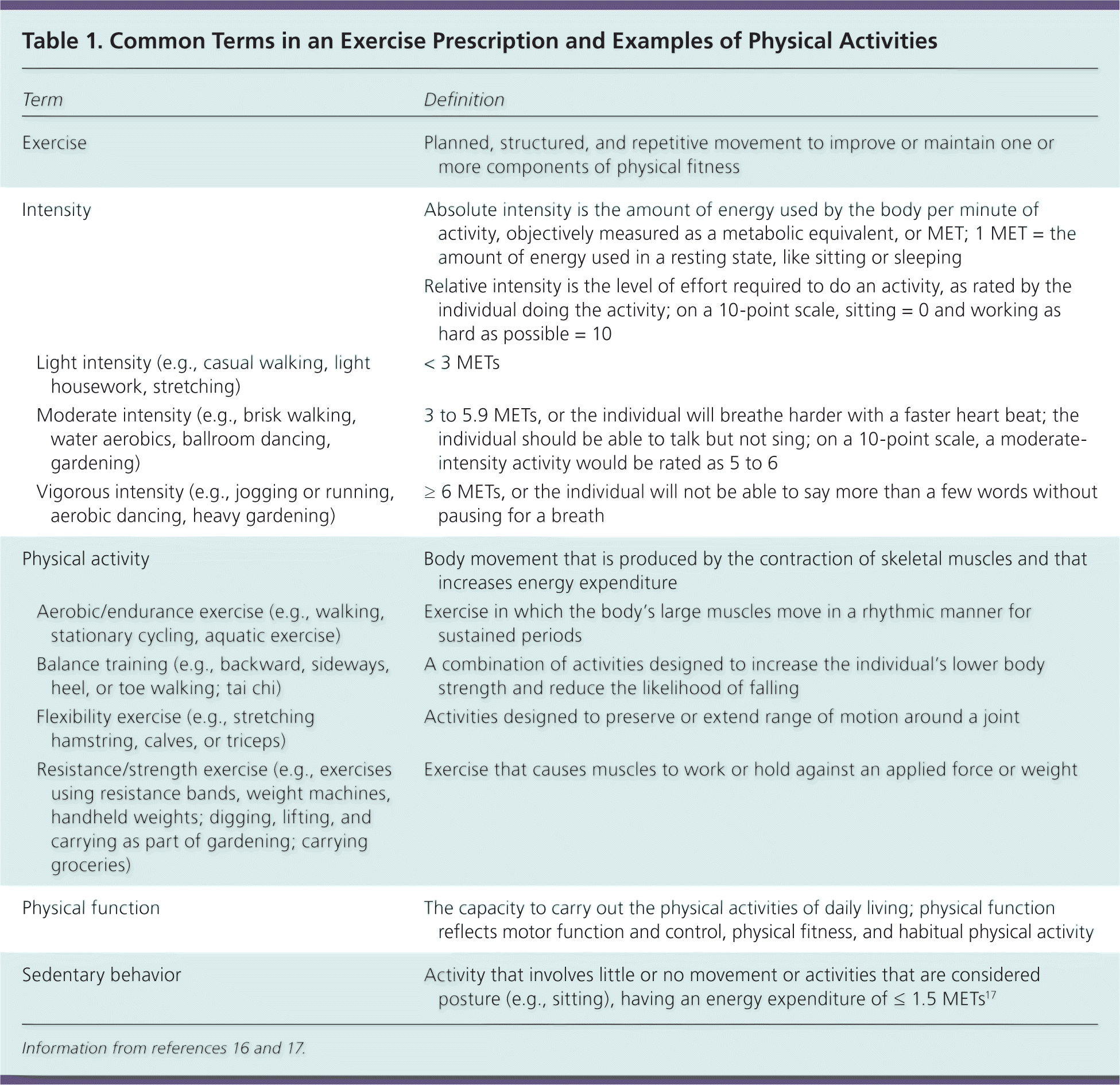
| Term | Definition | |
|---|---|---|
| Exercise | Planned, structured, and repetitive movement to improve or maintain one or more components of physical fitness | |
| Intensity | Absolute intensity is the amount of energy used by the body per minute of activity, objectively measured as a metabolic equivalent, or MET; 1 MET = the amount of energy used in a resting state, like sitting or sleeping | |
| Relative intensity is the level of effort required to do an activity, as rated by the individual doing the activity; on a 10-point scale, sitting = 0 and working as hard as possible = 10 | ||
| Light intensity (e.g., casual walking, light housework, stretching) | < 3 METs | |
| Moderate intensity (e.g., brisk walking, water aerobics, ballroom dancing, gardening) | 3 to 5.9 METs, or the individual will breathe harder with a faster heart beat; the individual should be able to talk but not sing; on a 10-point scale, a moderate-intensity activity would be rated as 5 to 6 | |
| Vigorous intensity (e.g., jogging or running, aerobic dancing, heavy gardening) | ≥ 6 METs, or the individual will not be able to say more than a few words without pausing for a breath | |
| Physical activity | Body movement that is produced by the contraction of skeletal muscles and that increases energy expenditure | |
| Aerobic/endurance exercise (e.g., walking, stationary cycling, aquatic exercise) | Exercise in which the body's large muscles move in a rhythmic manner for sustained periods | |
| Balance training (e.g., backward, sideways, heel, or toe walking; tai chi) | A combination of activities designed to increase the individual's lower body strength and reduce the likelihood of falling | |
| Flexibility exercise (e.g., stretching hamstring, calves, or triceps) | Activities designed to preserve or extend range of motion around a joint | |
| Resistance/strength exercise (e.g., exercises using resistance bands, weight machines, handheld weights; digging, lifting, and carrying as part of gardening; carrying groceries) | Exercise that causes muscles to work or hold against an applied force or weight | |
| Physical function | The capacity to carry out the physical activities of daily living; physical function reflects motor function and control, physical fitness, and habitual physical activity | |
| Sedentary behavior | Activity that involves little or no movement or activities that are considered posture (e.g., sitting), having an energy expenditure of ≤ 1.5 METs17 | |
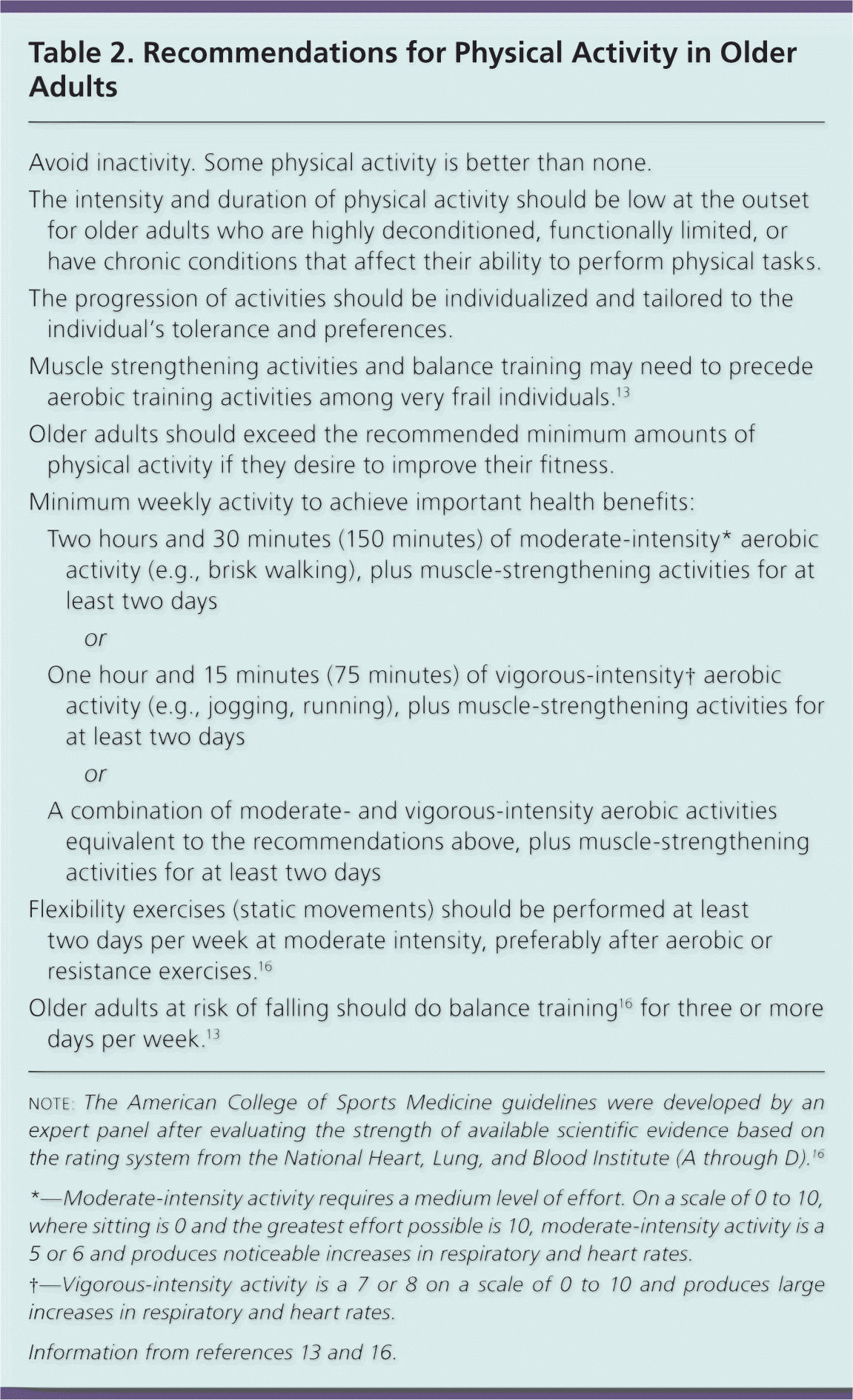
| Avoid inactivity. Some physical activity is better than none. | |||
| The intensity and duration of physical activity should be low at the outset for older adults who are highly deconditioned, functionally limited, or have chronic conditions that affect their ability to perform physical tasks. | |||
| The progression of activities should be individualized and tailored to the individual's tolerance and preferences. | |||
| Muscle strengthening activities and balance training may need to precede aerobic training activities among very frail individuals.13 | |||
| Older adults should exceed the recommended minimum amounts of physical activity if they desire to improve their fitness. | |||
| Minimum weekly activity to achieve important health benefits: | |||
| Two hours and 30 minutes (150 minutes) of moderate-intensity* aerobic activity (e.g., brisk walking), plus muscle-strengthening activities for at least two days | |||
| or | |||
| One hour and 15 minutes (75 minutes) of vigorous-intensity† aerobic activity (e.g., jogging, running), plus muscle-strengthening activities for at least two days | |||
| or | |||
| A combination of moderate- and vigorous-intensity aerobic activities equivalent to the recommendations above, plus muscle-strengthening activities for at least two days | |||
| Flexibility exercises (static movements) should be performed at least two days per week at moderate intensity, preferably after aerobic or resistance exercises.16 | |||
| Older adults at risk of falling should do balance training16 for three or more days per week.13 | |||
Physical activity prescriptions can first target increasing activity time, reducing sedentary time, or both, and then later increasing the intensity of the activity.18 In the beginning, the intensity and duration of physical activity should be low for older adults who are deconditioned or have physical function limitations, and then increased slowly as tolerated.16 For frail individuals, muscle strengthening activities and balance training may need to precede aerobic training activities.
GOAL SETTING
The initial adoption of physical activity is best predicted by readiness to change.19 Before writing an exercise prescription, physicians should educate the patient about the benefits of physical activity and motivate him or her with relevant personal goals,2 such as improving physical function or fitness, weight management, improving chronic disease management, and preventing falls.20 Once the patient is ready to start a physical activity program, the physician should help the patient set achievable goals (e.g., aim to increase brisk walking by 50 minutes a week rather than running three miles a day).
Physicians should instruct the patient to begin with activities that he or she can actually perform. The content and goals of the prescription need to be tailored individually to accommodate health status and functional capacity.5 The activities may be unstructured, such as activities of daily living (e.g., climbing stairs, walking to do an errand), or exercise programs, which are planned, structured, and repetitive movements to improve or maintain physical fitness (e.g., aerobics class, weight-lifting program). The four main categories of physical activities are aerobic/endurance, resistance/strength, balance, and flexibility exercises (Table 1).16,17
Older adults who are not familiar with exercise training may benefit from working with an experienced fitness trainer. A trainer who has experience working with older adults and is certified by an accredited organization such as the ACSM can educate patients on the benefits of exercise, as well as the optimal frequency, intensity, and duration of each type of exercise. A trainer can also help decrease the fear of injury from exercise.15 For patients with physical function limitations, such as gait impairment, physical therapy may help to restore physical function to prepare for exercise. Table 3 demonstrates the key components of the exercise prescription.
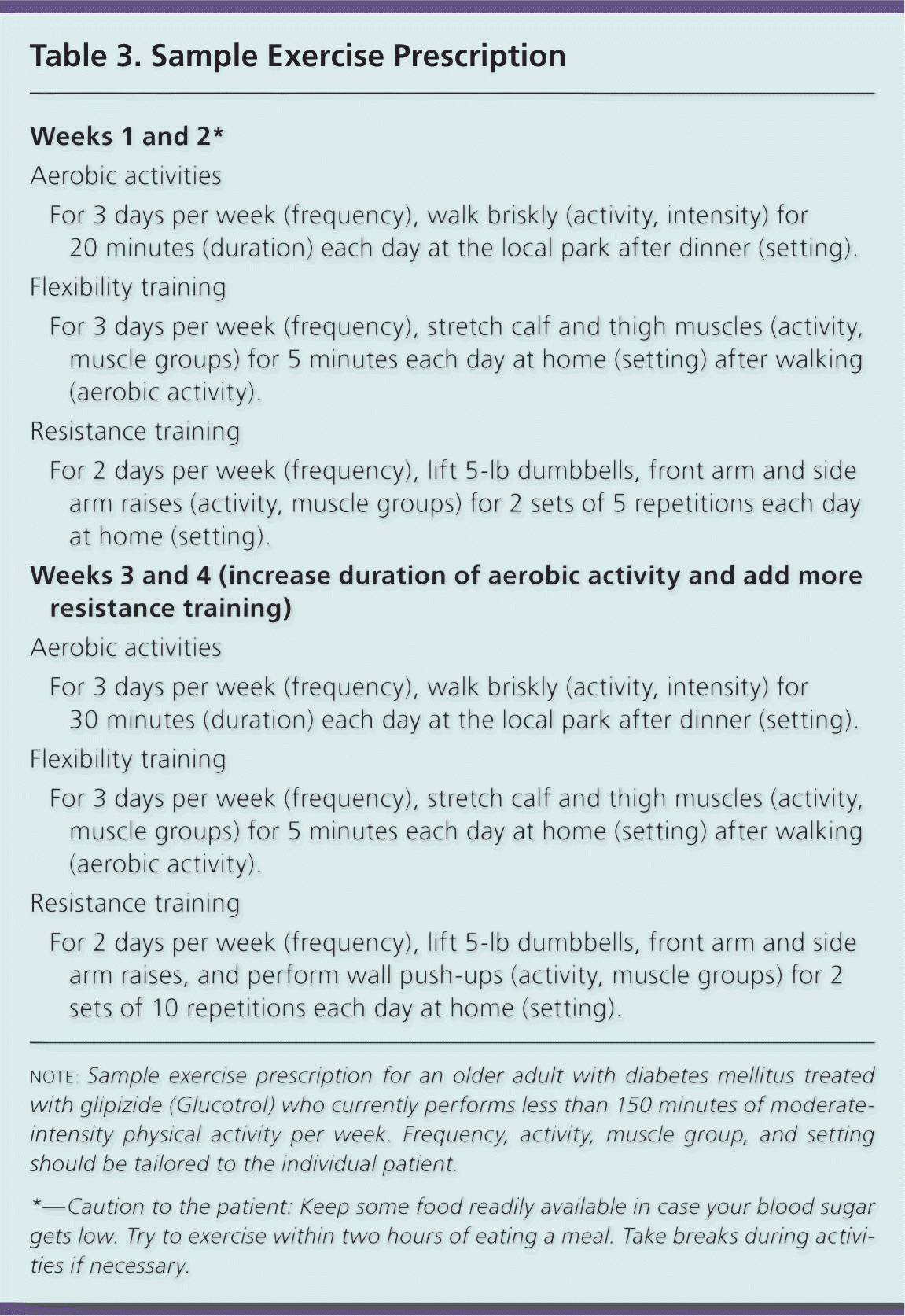
| Weeks 1 and 2* | |
| Aerobic activities | |
| For 3 days per week (frequency), walk briskly (activity, intensity) for 20 minutes (duration) each day at the local park after dinner (setting). | |
| Flexibility training | |
| For 3 days per week (frequency), stretch calf and thigh muscles (activity, muscle groups) for 5 minutes each day at home (setting) after walking (aerobic activity). | |
| Resistance training | |
| For 2 days per week (frequency), lift 5-lb dumbbells, front arm and side arm raises (activity, muscle groups) for 2 sets of 5 repetitions each day at home (setting). | |
| Weeks 3 and 4 (increase duration of aerobic activity and add more resistance training) | |
| Aerobic activities | |
| For 3 days per week (frequency), walk briskly (activity, intensity) for 30 minutes (duration) each day at the local park after dinner (setting). | |
| Flexibility training | |
| For 3 days per week (frequency), stretch calf and thigh muscles (activity, muscle groups) for 5 minutes each day at home (setting) after walking (aerobic activity). | |
| Resistance training | |
| For 2 days per week (frequency), lift 5-lb dumbbells, front arm and side arm raises, and perform wall push-ups (activity, muscle groups) for 2 sets of 10 repetitions each day at home (setting). | |
AEROBIC AND RESISTANCE EXERCISE
Aerobic exercises have numerous cardiovascular and musculoskeletal benefits for older adults,15 and resistance exercise training is the only therapy known to consistently improve muscle mass, strength, power, and quality, as well as overall physical function in older adults.21,22 Aging is associated with a decline in muscle strength and muscle power, which is a combination of force and speed. These changes can be described by muscle quality, measured as the force produced per unit of active muscle mass, which estimates the contribution from muscle mass, neuromuscular function, and mechanical, contractile, and architectural properties of muscle.23 The ACSM recommends that older adults perform the following each week: a minimum of 150 minutes of moderate-intensity aerobic activity or 75 minutes of vigorous-intensity aerobic activity, and two or more nonconsecutive days of moderate-intensity strengthening activities, with eight to 10 exercises involving the major muscle groups and eight to 12 repetitions of each exercise.16 This recommendation is consistent with the 2008 HHS Physical Activity Guidelines for Americans.13
FLEXIBILITY OR STRETCHING EXERCISES
Older adults with reduced joint flexibility may have difficulty performing daily activities such as dressing and reaching objects on a shelf. Flexibility or stretching exercises improve joint range of motion after three to four weeks of regular stretching at two to three times per week, but even greater gains are achieved with daily flexibility exercises.24 Flexibility exercise is most effective when performed after light-to-moderate aerobic or resistance exercise. Patients with recent joint injuries or surgery should consult with their physicians before performing flexibility exercises to avoid worsening injuries or impairing the healing of surgical wounds.
BALANCE AND PROPRIOCEPTIVE TRAINING
Balance and proprioceptive training should be a regular part of exercise for all older adults to prevent falls, especially in individuals at higher fall risk.16,20 Balance training involves practicing to control movements of the body's position while standing, but with reducing base of support (e.g., standing on one foot).16 Balance training should be practiced at least two hours per week, should be ongoing for lasting fall prevention effect, and may be group based or home based.25 To minimize the risk of falling during exercise, balance training should be closely supervised at first and begin with less challenging postures.
Monitoring Progress
After the patient begins a physical activity program, the physician should continue to monitor the progress periodically (e.g., at least once per year), provide encouragement, and help the patient overcome barriers such as lack of time or fatigue. Pedometer use has been shown to significantly increase physical activity if a step goal is set.26 The goal can be incremental increases of daily steps from baseline (e.g., by 10% every two weeks),26 or increases of daily walking time (e.g., by 10 minutes per day) until a step goal is reached.13
Older Adults with Chronic Medical Conditions
Older adults with chronic medical conditions can benefit from participating in regular physical activities (Table 4).16,21,27–35 Despite the concern for the risk of exercise-related cardiovascular events, stress testing is unnecessary for older adults who plan to participate in low- or moderate-intensity physical activities. Stress testing is recommended before vigorous exercise training in persons with known CVD.16 Physical activity may be contraindicated or restricted in a few medical conditions (e.g., decompensated congestive heart failure, severe aortic stenosis).36
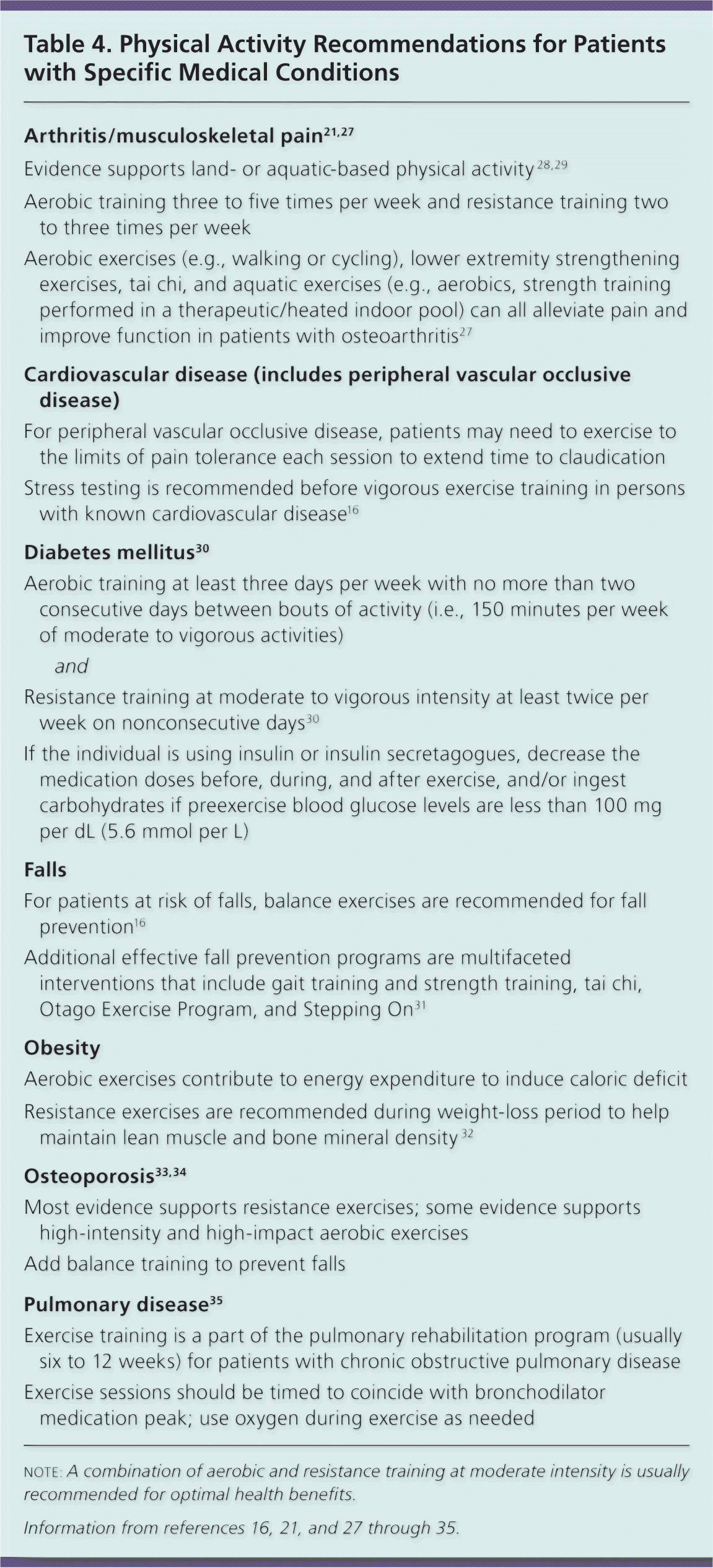
| Arthritis/musculoskeletal pain21,27 |
| Evidence supports land- or aquatic-based physical activity 28,29 |
| Aerobic training three to five times per week and resistance training two to three times per week |
| Aerobic exercises (e.g., walking or cycling), lower extremity strengthening exercises, tai chi, and aquatic exercises (e.g., aerobics, strength training performed in a therapeutic/heated indoor pool) can all alleviate pain and improve function in patients with osteoarthritis27 |
| Cardiovascular disease (includes peripheral vascular occlusive disease) |
| For peripheral vascular occlusive disease, patients may need to exercise to the limits of pain tolerance each session to extend time to claudication |
| Stress testing is recommended before vigorous exercise training in persons with known cardiovascular disease16 |
| Diabetes mellitus30 |
| Aerobic training at least three days per week with no more than two consecutive days between bouts of activity (i.e., 150 minutes per week of moderate to vigorous activities) |
| and |
| Resistance training at moderate to vigorous intensity at least twice per week on nonconsecutive days30 |
| If the individual is using insulin or insulin secretagogues, decrease the medication doses before, during, and after exercise, and/or ingest carbohydrates if preexercise blood glucose levels are less than 100 mg per dL (5.6 mmol per L) |
| Falls |
| For patients at risk of falls, balance exercises are recommended for fall prevention16 |
| Additional effective fall prevention programs are multifaceted interventions that include gait training and strength training, tai chi, Otago Exercise Program, and Stepping On31 |
| Obesity |
| Aerobic exercises contribute to energy expenditure to induce caloric deficit |
| Resistance exercises are recommended during weight-loss period to help maintain lean muscle and bone mineral density 32 |
| Osteoporosis33,34 |
| Most evidence supports resistance exercises; some evidence supports high-intensity and high-impact aerobic exercises |
| Add balance training to prevent falls |
| Pulmonary disease35 |
| Exercise training is a part of the pulmonary rehabilitation program (usually six to 12 weeks) for patients with chronic obstructive pulmonary disease |
| Exercise sessions should be timed to coincide with bronchodilator medication peak; use oxygen during exercise as needed |
OSTEOARTHRITIS
Land- and aquatic-based physical activities help patients with knee or hip osteoarthritis to reduce pain and increase mobility, muscle strength, joint flexibility, and aerobic endurance.28,29 The buoyancy of the water decreases joint loading, which can help decrease pain, and warm water may have a therapeutic effect. Once patients become more mobile, they can transition to land-based exercises.29 Land-based exercise improves pain and functional aerobic capacity more than aquatic activities.37
DIABETES MELLITUS
Regular physical activity as part of a lifestyle intervention can help prevent diabetes mellitus38; reduce physical functioning impairment among older patients with diabetes39; improve glucose levels, lipid levels, and blood pressure control; and enhance weight loss.30 Physical activity programs that include aerobic and resistance training have demonstrated improvement in A1C levels more than aerobic or resistance training alone.30,40 The ACSM and the American Diabetes Association recommend that previously sedentary individuals with diabetes who want to undertake activity more intense than brisk walking and individuals who have cardiovascular autonomic neuropathy undergo exercise stress testing before starting an exercise program.30
OBESITY
Weight loss, particularly unintentional, in older adults may lead to a loss of lean muscle and bone mineral density (BMD), which may lead to impaired physical function and disability. Exercise during an active weight-loss period can attenuate the loss of BMD and lean body mass.32 A study found that combining 5% to 7% (intentional) weight loss with regular physical activities, such as lifestyle activities or resistance training, resulted in improved mobility and lower extremity physical performance in overweight or obese older adults.41
OSTEOPOROSIS
Resistance exercises are effective for improving BMD in women and men. In a systematic review focusing on middle-aged and older men, resistance training alone or in combination with impact-loading activities was associated with more BMD improvement than walking.33 Individuals who already have osteoporosis and individuals with previous vertebral fractures are at risk of further vertebral fractures. It may be beneficial to consult with physical medicine and rehabilitation physicians on physical activities that will minimize this risk.
COGNITIVE IMPAIRMENT
Exercise training appears to improve cognition or lower the risk of dementia. In a randomized trial, older adults with mild cognitive impairment who added 142 minutes of exercise per week on average had modestly improved cognition compared with those who did not exercise.42 Exercise may also improve the ability to perform activities of daily living in persons with dementia and consequently reduce caregiver burden.43 Exercise intervention among patients with cognitive impairment should involve caregivers or be supervised by fitness trainers to ensure safety. Table 5 provides additional resources on physical activity for clinicians and patients.
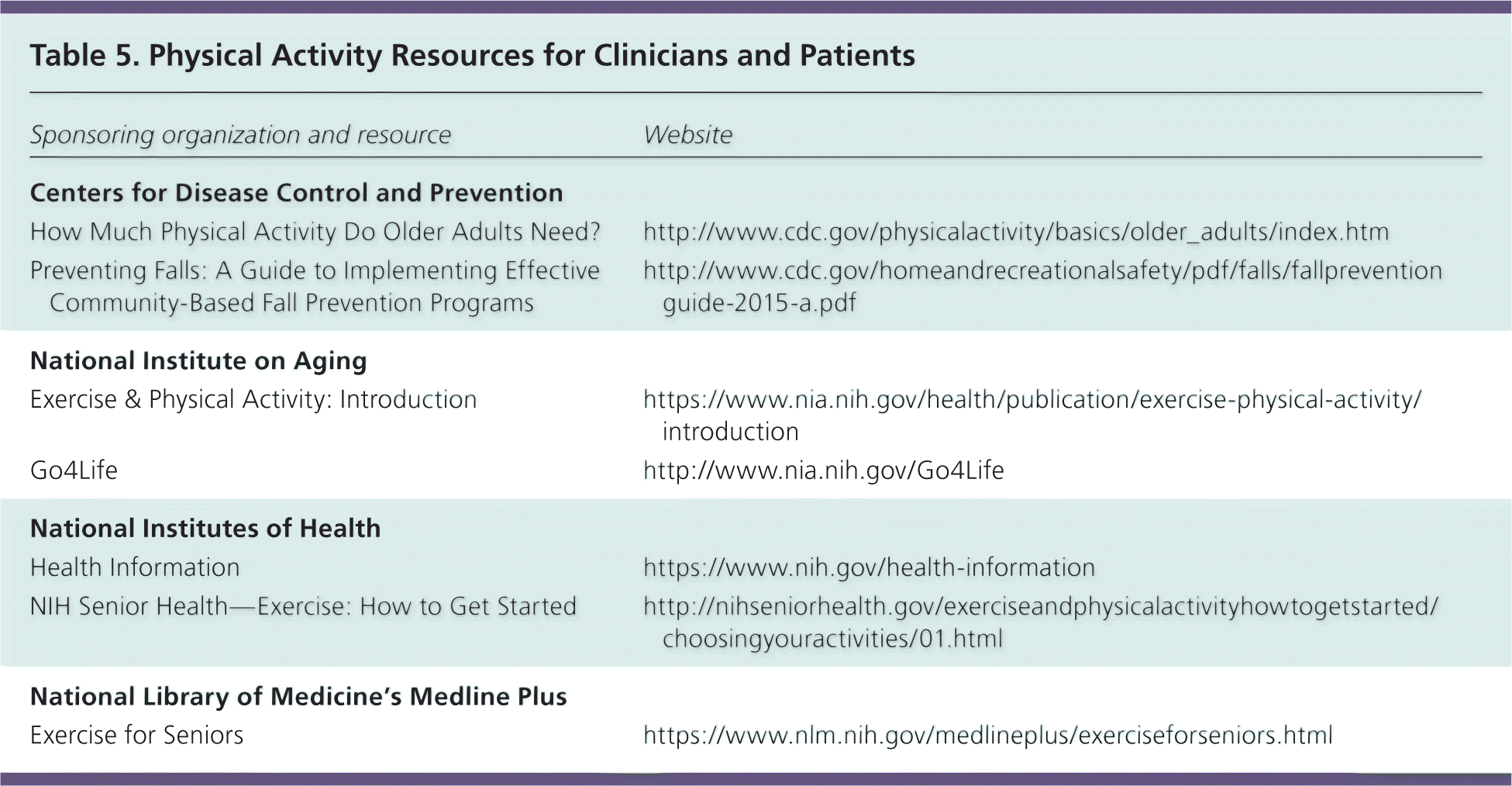
| Sponsoring organization and resource | Website |
|---|---|
| Centers for Disease Control and Prevention | |
| How Much Physical Activity Do Older Adults Need? | http://www.cdc.gov/physicalactivity/basics/older_adults/index.htm |
| Preventing Falls: A Guide to Implementing Effective Community-Based Fall Prevention Programs | http://www.cdc.gov/homeandrecreationalsafety/pdf/falls/fallpreventionguide-2015-a.pdf |
| National Institute on Aging | |
| Exercise & Physical Activity: Introduction | https://www.nia.nih.gov/health/publication/exercise-physical-activity/introduction |
| Go4Life | http://www.nia.nih.gov/Go4Life |
| National Institutes of Health | |
| Health Information | https://www.nih.gov/health-information |
| NIH Senior Health—Exercise: How to Get Started | http://nihseniorhealth.gov/exerciseandphysicalactivityhowtogetstarted/choosingyouractivities/01.html |
| National Library of Medicine's Medline Plus | |
| Exercise for Seniors | https://www.nlm.nih.gov/medlineplus/exerciseforseniors.html |
This article updates previous articles on this topic by Elsawy and Higgins,44 McDermott and Mernitz,45 and Nied and Franklin.46
Data Sources: PubMed, Cochrane Review, and Essential Evidence Plus are the primary sources for the article. Keywords include walking, older age, exercise, physical activity, exercise prescription, falls, osteoporosis, diabetes, osteoarthritis, dementia, and depression. Search dates: September 17, 2015, to September 16, 2016.
